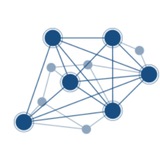🎞 Machine Learning with Graphs: Generative Models for Graphs, Erdos Renyi Random Graphs, The Small World Model, Kronecker Graph Model
💥Free recorded course by Jure Leskovec, Computer Science, PhD
💥This lecture, will cover generative models for graphs. The goal of generative models for graphs is to generate synthetic graphs which are similar to given example graphs. The simplest model for graph generation, Erdös-Renyi graph (E-R graphs, Gnp graphs). The small-world graphs (Watts–Strogatz graphs, W-S graphs). Even though the E-R graphs can fit the average path length of real-world graphs, its clustering coefficient is much smaller than real-world graphs. The small-world model is proposed to generative realistic graphs with both low diameter and high clustering coefficient. Specifically, W-S graphs are generative by randomly rewring edges from regular lattic graphs. The Kronecker Graph model, where graphs are generated in a recursive manner. The key motivation is that real-world graphs often exhibit self-similarity, where the whole structure of the graph has the same shape as its parts. Kronecker graphs are generated by recursively doing Kronecker product over the initiator matrix, which is trained to fit the statistics of the input dataset. We further discuss fast Kronecker generator algorithms. Finally, we show that Kronecker graphs and real graphs are very close in many important graph statistics.
📽 Watch: part1 part2 part3 part4
📲Channel: @ComplexNetworkAnalysis
#video #course #Graph #Machine_Learning #Erdos_Renyi #Small_World #Kronecker_Graph
💥Free recorded course by Jure Leskovec, Computer Science, PhD
💥This lecture, will cover generative models for graphs. The goal of generative models for graphs is to generate synthetic graphs which are similar to given example graphs. The simplest model for graph generation, Erdös-Renyi graph (E-R graphs, Gnp graphs). The small-world graphs (Watts–Strogatz graphs, W-S graphs). Even though the E-R graphs can fit the average path length of real-world graphs, its clustering coefficient is much smaller than real-world graphs. The small-world model is proposed to generative realistic graphs with both low diameter and high clustering coefficient. Specifically, W-S graphs are generative by randomly rewring edges from regular lattic graphs. The Kronecker Graph model, where graphs are generated in a recursive manner. The key motivation is that real-world graphs often exhibit self-similarity, where the whole structure of the graph has the same shape as its parts. Kronecker graphs are generated by recursively doing Kronecker product over the initiator matrix, which is trained to fit the statistics of the input dataset. We further discuss fast Kronecker generator algorithms. Finally, we show that Kronecker graphs and real graphs are very close in many important graph statistics.
📽 Watch: part1 part2 part3 part4
📲Channel: @ComplexNetworkAnalysis
#video #course #Graph #Machine_Learning #Erdos_Renyi #Small_World #Kronecker_Graph
YouTube
Stanford CS224W: Machine Learning with Graphs | 2021 | Lecture 14.1 - Generative Models for Graphs
For more information about Stanford’s Artificial Intelligence professional and graduate programs, visit: https://stanford.io/3jO8OsE
Jure Leskovec
Computer Science, PhD
In this lecture, we will cover generative models for graphs. The goal of generative…
Jure Leskovec
Computer Science, PhD
In this lecture, we will cover generative models for graphs. The goal of generative…
👍5
